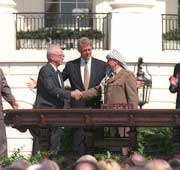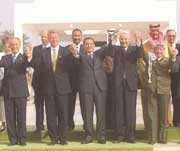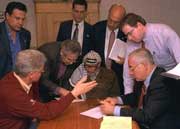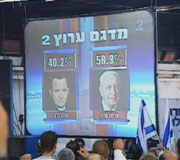 |  |  |  |  |  |  |
 |
Sept. 13, 1993 |  |
 | Oslo peace accord signed; core issues to be resolved
later | |  |
 |
 |  | |

The historic Oslo accord is signed at the White House. Palestinians and
Israelis agree to recognize the other's right to exist: "It is time to put an
end to decades of confrontation and conflict" and "strive to live in peaceful
coexistence and mutual dignity and security and achieve a just, lasting, and
comprehensive peace." Soon Israel begins its promised withdrawal from lands
occupied since the 1967 war; Jericho and Gaza are transferred to the
Palestinians. Yasser Arafat -- Israel's implacable enemy for 30 years --
returns from exile to establish the Palestinian Authority. The parties agree
that the most sensitive "final status" issues -- permanent borders, Jewish
settlements, Palestinian refugees, and Jerusalem -- will be addressed later.
| |
 |  |
 |
Oct. 14, 1994 |  |
 | Nobel Peace Prize awarded | |  |
 |
 |  | |

Israeli Prime Minister Yitzhak Rabin, Israeli Foreign Minister Shimon Peres,
and Yasser Arafat are awarded the Nobel Peace Prize for their roles in the Oslo
accord.
| |
 |  |
 |
Sept. 28, 1995 |  |
 | Oslo II signed | |  |
 |
 | |

In Washington, D.C., Rabin and Arafat sign the Oslo II agreement, which
provides for Palestinian self-rule in parts of the West Bank and also sets the
framework for Palestinian elections. Under Oslo II, the West Bank is divided
into three areas: Area A, which is under exclusive Palestinian control; Area B,
where Palestinians have civilian control and Israelis control security; and
Area C, which is controlled exclusively by Israel. The following week, the
agreement is ratified by a slim margin in the Knesset, where Rabin faces harsh
criticism from those in the conservative Likud Party.
 | |
 |
Nov. 4, 1995 |  |
 | Rabin assassinated | |  |
 |
 | |

Following a peace rally in Tel Aviv, Yitzhak Rabin is assassinated by a Jewish extremist. He is succeeded by Peres.
 | |
 |
Dec. 8, 1995 |  |
 | Israel to withdraw from major Palestinian cities | |  |
 |
 | |

Arafat and Peres meet to reaffirm their
commitment to the Oslo accords. Israel would release 1,000 Palestinian prisoners. By the end of the month, Israel has also withdrawn its troops from an additional five major Palestinian cities.
Within the Israeli opposition, these concessions are seen as a dangerous
strategic mistake. And while many Palestinians rejoice, some -- including those
in the Islamic fundamentalist group Hamas, which gained power among Palestinians by controlling the mosques and providing food and education to the poor -- oppose any compromise with
Israel.
 | |
 |
Jan. 20, 1996 |  |
 | Palestinian Authority holds first elections | |  |
 |
 | |

Palestinian elections are held as required by the Oslo accord. Hamas, protesting peace
negotiations with Israel, calls for a boycott of the elections. But
Palestinians endorse the peace process by giving Arafat an overwhelming
victory.
 | |
 |
Feb. 25 - March 4, 1996 |  |
 | Suicide attacks kill dozens; Palestinian security
forces arrest thousands | |  |
 |
 | |

Several weeks after Israel assassinates Hamas' chief bomb-maker, Hamas
retaliates. Three suicide attacks in eight days leave 46 dead and hundreds
wounded. Then, on March 4, 1996, a fourth suicide bomber explodes himself, this
time in a Tel Aviv mall. Thirteen people are killed and 157 more wounded; the
dead are all under 17 years old. Arafat orders his security forces to move
against the Islamic militants and some 2,000 people are arrested. The peace process -- and its principle advocate, Shimon Peres -- comes under increasing attack.
 | |
 |
March 13, 1996 |  |
 | "Summit of Peacemakers" convenes at Sharm el-Sheik | |  |
 |
 |  | |

Israeli opposition to the peace process coalesces around Benjamin Netanyahu, the
new leader of the Likud Party who is poised to challenge Peres and his Labor
Party in the upcoming election. Fearing Peres' defeat and the demise of the
peace process, Egypt and the United States convene world leaders in the Sinai
resort of Sharm el-Sheik. They call it the Summit of Peacemakers and hope to
influence the Israeli electorate to support Peres.
| |
 |  |
 |
April 11-18, 1996 |  |
 | Hezbollah-Israel clash; Israel accidentally bombs U.N.
compound | |  |
 |
 | |

Violence erupts along Israel's northern border. Hezbollah, the radical Shiite
movement based in Lebanon that shares Hamas' disdain for the peace process,
fires missiles into Israeli villages and towns, prompting Israel to launch a
massive bombardment of Hezbollah bases in southern Lebanon. A week later, in a
case of mistaken targeting, Israeli artillery hits a United Nations compound
near the village of Kana, where civilians have sought shelter from the attacks.
More than 100 are killed.
Israeli Arabs, fervent supporters of Peres and his Labor Party, are now
outraged and turn against him, calling for a boycott of the upcoming election.
 | |
 |
May 29, 1996 |  |
 | Netanyahu narrowly defeats Peres | |  |
 |
 |  | |

Since Israeli Arabs constitute 20 percent of Israel's population, their boycott
of the election helps elect Netanyahu: He defeats Peres by a mere one-half of
1 percent. At 47, he becomes Israel's youngest prime minister.
| |
 |  |
 |
Sept. 4, 1996 |  |
 | Tense first meeting between Arafat and Netanyahu | |  |
 |
 | |

Arafat and Netanyahu meet at the Erez border crossing between Gaza and Israel.
The meeting between the two men is fraught with tension, but their handshake,
though largely ceremonial, is still a symbol of hope.
 | |
 |
Sept. 24, 1996 |  |
 | Netanyahu opens tunnel along Western Wall in Jerusalem;
violent protests erupt | |  |
 |
 | |

In an area extremely sensitive to both Muslims and Jews -- where the Al Aqsa
mosque on the Temple Mount sits above the Western Wall -- Netanyahu changes the
status quo and opens an ancient tunnel that runs along the wall. Netanyahu's
security advisers had warned him against opening the tunnel, fearing that the
move was too provocative.
Palestinian radicals are quick to exploit the situation and organize
demonstrations. The Israeli army fires upon the demonstrators and for the first
time since the Oslo accord was signed, the Palestinian police use their guns
against the Israeli army. Netanyahu gives the order to move Israel's tank
forces into striking positions. The violence leaves 59 Palestinians and 16
Israelis dead. Hundreds more are wounded on both sides before Palestinian and
Israeli security forces cooperate to bring an end to the fighting.
 | |
 |
Oct. 1-2, 1996 |  |
 | Arafat, Netanyahu attend summit in Washington, D.C. | |  |
 |
 | |

In an attempt to prevent further violence and restart negotiations, Arafat and
Netanyahu are summoned to Washington by U.S. President Bill Clinton. Clinton
also asks King Hussein of Jordan to join the talks. By the end of the summit,
Netanyahu and Arafat agree to resume talks on further implementation of the
Oslo accords.
 | |
 |
Jan. 15, 1997 |  |
 | Israel to withdraw from Hebron | |  |
 |
 | |

After four months of
difficult negotiations, Israel agrees to withdraw from Hebron, leaving behind
only a small enclave of Jewish settlers. Now Arafat's Palestinian Authority
controls all of the major cities in the West Bank and Gaza. Palestinians cheer
the withdrawal, but Jewish settlers feel betrayed by Netanyahu.
 | |
 |
March 18, 1997 |  |
 | Construction begins on Jewish settlement near
Jerusalem | |  |
 |
 |  | |

Three weeks after Netanyahu gives the green light, construction begins on a
settlement on a contested hill near Jerusalem. Although Jewish settlements were
not mentioned specifically in the Oslo accords, Rabin had promised that no
additional ones would be built. Tensions are high.
| |
 |  |
 |
March 21, 1997 |  |
 | Suicide bomber strikes Tel Aviv | |  |
 |
 | |

In Tel Aviv, a suicide bomber explodes himself in a packed café.
 | |
 |
July 30, 1997 |  |
 | Two suicide attacks kill 16 in Jerusalem | |  |
 |
 | |

Two suicide attacks rip through Jerusalem's main market within 10 minutes of
each other. Sixteen are killed and hundreds are wounded. In response, Israel
limits access in and out of Palestinian territories and enforces a strict
curfew.
 | |
 |
Sept. 4, 1997 |  |
 | Three suicide attacks in Jerusalem; Netanyahu blocks land
transfers to Palestinians | |  |
 |
 | |

Three more suicide bombers strike at the heart of Jerusalem. Five Israelis are
killed and more than 200 wounded. Netanyahu declares that no more land will be
handed over to the Palestinians as long as terror continues.
 | |
 |
Sept. 10-12, 1997 |  |
 | Albright visits Israel amidst unrest | |  |
 |
 | |

To try to contain the growing crisis, the new U.S. Secretary of State,
Madeleine Albright, is dispatched to the area. It is her first trip to Israel.
 | |
 |
Sept. 14, 1997 |  |
 | Jewish settlers occupy houses in Arab sections of
Jerusalem | |  |
 |
 | |

Netanyahu allows Jewish settlers to occupy houses within Arab sections of
Jerusalem, once again changing the status quo. Palestinians demonstrating
against Jewish settlers are joined by groups of Israelis who oppose Netanyahu's
policies.
 | |
 |
Oct. 15-23, 1998 |  |
 | Summit at Wye River Plantation in Maryland | |  |
 |
 |  | |

The U.S. calls this meeting in another attempt to revive the peace process. At
first, the two sides are mired in disagreements. But after Clinton pushes a
marathon 21-hour session, both Palestinians and Israelis agree to what becomes
known as the Wye River Memorandum.
The agreement allows for the construction of an international airport for the
Palestinians in the Gaza Strip. Israel agrees to pull back its forces from an
additional 13 percent of the West Bank and to release 750 Palestinian security
prisoners. (Ultimately, only half of the pull-back is finished and only 250
prisoners are released.) The Palestinian Authority agrees to combat terrorist
organizations, to arrest those involved in terrorist activities, and to collect
all illegal weapons and explosives. (Little or none of this is ever done.)
| |
 |  |
 |
Dec. 12-14, 1998 |  |
 | Clinton visits Gaza; Palestinian National Council rescinds
anti-Israel clause | |  |
 |
 | |

In an extraordinary gesture, Clinton comes to Gaza to lend his prestige to the
implementation of portions of the Wye agreements. In Clinton's presence, the
Palestinian National Council takes a historic step: Its members vote to rescind
the clause in the PLO Charter that calls for the destruction of the State of
Israel. The extremists Arafat is supposed to control stage violent protests
against the recognition of Israel.
 | |
 |
Jan. 4, 1999 |  |
 | Knesset rebukes Netanyahu | |  |
 |
 | |

In Israel, the people who had brought Netanyahu into power see the handover of
more territory -- as called for by Wye -- as an act of betrayal. The Knesset
convenes in an extraordinary session. Over two-thirds of its members -- from
all across the political spectrum -- rebuke Netanyahu and call for new
elections. Opposing Netanyahu is Labor Party head Ehud Barak, a former chief of
staff, Israel's most decorated military hero, and a disciple of the late Prime
Minister Yitzhak Rabin. He runs on a platform of peace and reconciliation with
the Palestinians.
 | |
 |
May 17, 1999 |  |
 | Barak defeats Netanyahu in landslide | |  |
 |
 | |

Barak wins a landslide victory, becoming Israel's 14th prime minister. While
his mandate is strong, Barak wants to push quickly for a permanent agreement,
skipping the interim Israeli redeployments called for in the Wye accords. He envisions
a two-state solution that will finally put an end to the conflict.
 | |
 |
July 11, 1999 |  |
 | Barak, Arafat meet; no agreement on redeployment | |  |
 |
 | |

Barak flies to the Erez crossing on the Israel-Gaza border for his first
official meeting with the Palestinian leadership. The Palestinians expect to
obtain a commitment from Barak to immediately implement the long-delayed Israeli redeployment. Barak dismisses the idea and the talks disintegrate.
 | |
 |
Sept. 3-5, 1999 |  |
 | Sharm El-Sheikh Memorandum | |  |
 |
 | |

After five weeks of talks between the two principal negotiators -- Saeb Erekat
for the Palestinians; Gilead Sher for Israel -- the two sides agree on a bold
framework and timetable for the final peace agreement. It is signed by Arafat
and Barak. The Palestinian and Israeli delegations assemble in Egypt at Sharm
el-Sheik to celebrate the fruits of the negotiators' efforts. As a
confidence-building measure, Israel agrees to release 350 security prisoners in
two phases. The Palestinians agree to enforce the existing security
understandings.
 | |
 |
November 1999 |  |
 | Negotiations resume; Palestinians chafe at Israelis' West
Bank proposal | |  |
 |
 | |

Land and the settlements -- still expanding under Barak -- become the main
issues when negotiations resume. Questions remain over the 180,000 Israeli
settlers in the West Bank and Gaza and how much land Israel will cede to the
Palestinians. The Palestinians are outraged by the Israeli proposal, saying
that it would cut the West Bank in three parts and allow Israel to continue the
settlements.
Not long after, secret negotiations in Stockholm deal with another contentious
issue -- the Palestinian refugees. Three million displaced people demand the
right to return, a number roughly equal to half of the population of Israel.
Their return would alter the nature of the Jewish state.
 | |
 |
May 24, 2000 |  |
 | Israel withdraws from southern Lebanon after 22 years | |  |
 |
 | |

Barak fulfills a campaign promise and ends Israel's 22-year occupation of
southern Lebanon. Hezbollah, the Shiite Muslim fundamentalist militia that had
been fighting the Israeli army in Lebanon for years, sees Israel's flight as a
massive victory. Many Palestinians now believe they, too, can achieve their
aims by fighting rather than negotiating.
In Israel, Barak is under fire for his withdrawal from Lebanon and for being
ineffectual with the Palestinians. He urges Clinton to hold a summit to resolve
everything once and for all.
 | |
 |
July 11-25, 2000 |  |
 | Leaders attend Camp David summit | |  |
 |
 |  | |

The leaders head off to a hastily prepared summit at Camp David. Issues never
before discussed at senior levels between Israelis and Palestinians --
Jerusalem, statehood, boundaries, refugees -- are put on the table.
To break the impasse over the West Bank, Clinton proposes a compromise: Israel
would return almost all of the West Bank and Gaza to the Palestinians; the two
sides would swap small parcels of land important to each other; and they would
agree to share control of Jerusalem. Barak uses Clinton's proposal as a
starting point and suggests several changes. Arafat never replies and Barak
then refuses to negotiate with Arafat directly.
When Clinton returns to Camp David from a trip to Okinawa, Jerusalem is again
put on the table. Arafat argues that the Jews have no claim at all to the area
of the Temple Mount. On the last night of the talks, Clinton offers a new
bridging proposal that covers all the issues, including the main stumbling
block of East Jerusalem. But Arafat refuses any compromise over the Temple
Mount and is concerned with limits on the sovereignty for the new
Palestinian entity (the Clinton/Barak plan would have left the new Palestinian
state with significant loss of
water and good land, almost split by Israeli annexation running east from
Jerusalem, and with Israel getting roughly 9 percent of the West
Bank). Arafat rejects
the proposal. 
| |
|

Arafat returns home to a hero's welcome. Calls for an uprising -- a new
intifada -- are heavy in the air. Despite the official demise of the talks,
Arafat and Barak approve a new series of secret meetings between the
negotiators.
 | |
 |
Sept. 25, 2000 |  |
 | Arafat visits Barak's private residence | |  |
 |
 | |

Arafat visits Barak at his private residence. According to many of those
present, the meeting goes well. At the end of the evening, Arafat makes a
request of Barak: that Ariel Sharon, the head of Israel's right-wing party, be
denied permission to visit the Temple Mount. Barak, however, cannot prevent
Sharon's visit. Instead, he coordinates with the Palestinian Authority, which agrees to try to keep peace in the area.
 | |
 |
Sept. 28, 2000 |  |
 | Sharon visits the Temple Mount; Al Aqsa intifada is
born | |  |
 |
 | |

The Al Aqsa intifada, or uprising, is born as a result of Sharon's visit to the Temple
Mount. By day's end, seven protestors are dead and 160 injured. The riots
spread quickly throughout the West Bank and Gaza and engulf the Israeli Arab
community as well. After a week of fighting, 50 Palestinians and five Israelis
are dead.
 | |
 |
Oct. 12, 2000 |  |
 | Israeli reservists killed; Israel launches massive assault | |  |
 |
 | |

Two Israeli reservists accidentally stray into Palestinian territory and are
lynched by a Palestinian mob. Israel blames the Palestinian Authority for the
murders and within hours attack-helicopters destroy the police station, the
site of the lynching. Israel also launches massive attacks on other targets in
Gaza and the West Bank.
In Israel, Barak's policies are blamed for the rapidly deteriorating situation.
Even among his staunchest supporters, many now distrust the Palestinians'
intentions.
 | |
 |
Dec. 9, 2000 |  |
 | Barak announces resignation | |  |
 |
 | |

By resigning Barak obtains a window of 60 days to regain support before
standing for reelection. But the violence has made his pro-negotiation stance
difficult to defend.
Likud leader Sharon -- the hard-line former general whose visit to the Temple
Mount sparked the intifada -- runs on a platform of security and is far
ahead in the polls. Barak's only hope is to conclude a deal with the
Palestinians quickly.
 | |
 |
Jan. 21-27, 2001 |  |
 | Negotiations in Taba; no agreement | |  |
 |
 | |

In a desperate attempt to reach an agreement before the election, negotiators
meet in the resort town of Taba, Egypt, focusing on a new framework for an
agreement that had been developed by Clinton the previous month. The new
terms go further than what Israel and the U.S. had offered at Camp David. The
negotiators move rapidly toward reconciling the differences in this new
framework, but they run out of political time. They are unable to conclude an
agreement with Clinton now out of office and Barak standing for reelection in
two weeks.
 | |
 |
Feb. 6, 2001 |  |
 | Sharon defeats Barak in landslide | |  |
 |
 |  | |

Sharon is elected prime minister of Israel, defeating Barak in a landslide. Now
Arafat and Sharon, two leaders who harbor deep mutual animosity and mistrust,
will shape the next chapter in the tumultuous history of the Middle East.
Soon, the political process stops and the old cycle of
violence and counterviolence continues. Palestinian suicide bombings become an
almost daily event. Israeli retaliation leaves hundreds of Palestinians dead.
| |
 |  |
 |
March 29, 2002 |  |
 | Israel launches Operation Defensive Shield | |  |
 |
 | |

Two days after a suicide bomber explodes himself in a Netanya hotel on Passover and kills 30 people, Israel launches Operation Defensive Shield. With
overwhelming force, Israeli troops reenter Palestinian cities and refugee
camps, hunting down terrorists and often leaving massive destruction in their
wake. In Ramallah, Israeli forces enter Arafat's compound and hold him captive and isolated for 31 days.
 | |
 |
June 19-20, 2002 |  |
 | Two suicide bombings in Jerusalem; Israel begins retaking
West Bank land | |  |
 |
 | |

Two bombings kill more than two dozen Israelis in Jerusalem. Arafat denounces the attacks, saying
they "have nothing to do with our national rights in legitimate resistance to
Israeli occupation." Sharon announces Israel will immediately begin a policy
of retaking land in the West Bank, and holding it, until the terror attacks stop.
 | |